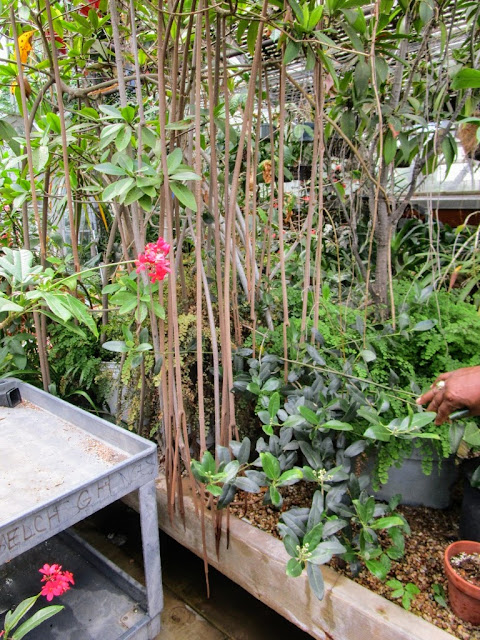Back in early May I joined a group from Gardening Volunteers of South Texas on a field trip to the research greenhouses at The University of Texas at Austin.
My previous post focused on the extensive cactus collection and in this post we'll tour more standing collections and see some of the research in progress at UT. The tour was conducted by GVST scholarship recipient Garrett Flores. Each year GVST awards scholarships to a horticultural student at UT and Texas A&M University.
Garrett discusses Ghost Pepper heat which is one of the hottest peppers at 800,000 to 1,000,000 in Scoville heat units. For reference the Jalapeno pepper comes in around 3,500 on the Scoville scale. Garrett has tried the Ghost Pepper and says it is extremely hot. We took his word for it.
These little guys pack a punch.
Blooming begonia among the tropical plants in the greenhouse.
Garrett has been propagating Bromeliads.
He also propagated plants as gifts for our group and we were invited to take a plant or two home with us. I chose a white blooming vine of which I forgot the name but I'm sure I'll figure it out when it blooms.
We all enjoyed learning more about the plants and research at UT.
Turn a bunch of serious gardeners loose among beautiful plants and this is what you'll see. GVST member Pat DeWinne pointing out a blooming orchid.

On to some of the research taking place in the greenhouses. Cotton is an important crop in Texas and research to improve production is ongoing. These plants yield 10x more Cotton than current commercial crops. Cotton is in the mallow family and produces beautiful flowers like the pink and cream bloom shown below near the pot.

We grow a lot of rice in Texas, much of which is exported. With less land in production, research for higher yields is important to our economy.
Grasses grown for a biofuel study.
After finishing our tour of the research greenhouses we headed past the famous Turtle Pond to the
BOT Greenhouse.
This elegant building was constructed from a Lord and Burnham Conservatory kit in 1929 and in the 1950s a couple of additional Lord and Burnham kits were added.
We enjoyed spending time in this space chock full of tropical plants which comprise the standing collection

We were mesmerized by all the beautifully maintained specimen plants.


Orchids in bloom.
Blooming Coconut Orchid which really does smell like coconut. The orange cells are part of a cooling system, similar to a swamp cooler which was common before air conditioning. Air drawn through the wet cells cools it for distribution through the greenhouse. If you've been in an uncooled greenhouse in a Texas summer you know the need for some type of cooling system.

Pitcher plant
It was fun to see this Ramie plant. I had received one from my friend Melody and we had quite a challenge figuring out what it was.
Ferns and more Ferns.
Begonias.....
Another blooming Desert Rose
A Mangrove tree!
Gorgeous Hoya bloom. I had so many helpers on this trip. Thank you Karen!
That's the end of our tour.
Much needed new greenhouses are under construction. At nearly a century old, the BOT has served well but it is hard to maintain so all these collections will eventually move to the new facility.
Currently the greenhouses are
open by appointment for educational tours.
________________________
If you'd like to join future GVST field trips, check out the
Gardening Volunteers of South Texas (GVST) website and sign up for email notifications.
GVST holds gardening classes on the third Monday of each month from noon to 3pm. The classes are free and open to the public, we do request a $5 donation to help with expenses. No dues, no required hours or attendance--just a interest in learning about gardening. For more information see the
link.












































